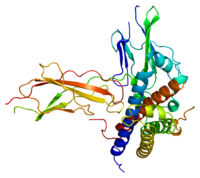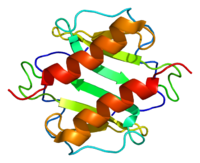
Genetic diversification of chemokine CXCL16 and its receptor CXCR6 in primates
Sign Up to like & getrecommendations! Published in 2018 at "Developmental and Comparative Immunology"
DOI: 10.1016/j.dci.2018.04.005
Abstract: ABSTRACT Chemokine CXCL16 and its receptor CXCR6 are associated with a series of physiological and pathological processes in cooperative and stand‐alone fashions. To shed insight into their versatile nature, we studied genetic variations of CXCL16… read more here.
Keywords: cxcr6; diversification; receptor cxcr6; cxcl16 receptor ... See more keywords

Higher CXCL16 exodomain is associated with aggressive ovarian cancer and promotes the disease by CXCR6 activation and MMP modulation
Sign Up to like & getrecommendations! Published in 2019 at "Scientific Reports"
DOI: 10.1038/s41598-019-38766-6
Abstract: Ovarian cancer (OvCa) is the leading cause of death from gynecological malignancies. Five-year survival rate of OvCa ranges from 30–92%, depending on the spread of disease at diagnosis. Role of chemokines is well appreciated in… read more here.
Keywords: ovca; cxcr6; higher cxcl16; cxcl16 ... See more keywords

CXCR6 Inhibits Hepatocarcinogenesis by Promoting Natural Killer T- and CD4+ T-Cell-Dependent Control of Senescence.
Sign Up to like & getrecommendations! Published in 2019 at "Gastroenterology"
DOI: 10.1053/j.gastro.2019.01.247
Abstract: BACKGROUND & AIMS Inflammation in the liver provokes fibrosis, but inflammation is also important for tumor surveillance. Inhibitors of chemokine pathways, such as CXCL16 and CXCR6 regulation of lymphocyte trafficking, are being tested as antifibrotic… read more here.
Keywords: cxcr6; natural killer; hepatocarcinogenesis; mice ... See more keywords

Functional role of endothelial CXCL16/CXCR6-platelet–leucocyte axis in angiotensin II-associated metabolic disorders
Sign Up to like & getrecommendations! Published in 2018 at "Cardiovascular Research"
DOI: 10.1093/cvr/cvy135
Abstract: Aims Angiotensin-II (Ang-II) is the main effector peptide of the renin-angiotensin system (RAS) and promotes leucocyte adhesion to the stimulated endothelium. Because RAS activation and Ang-II signalling are implicated in metabolic syndrome (MS) and abdominal… read more here.
Keywords: cxcr6; cxcl16 cxcr6; cxcl16; functional role ... See more keywords

Abstract 1924: Role of CXCL16 and ADAM10 in ovarian cancer pathogenesis
Sign Up to like & getrecommendations! Published in 2018 at "Cancer Research"
DOI: 10.1158/1538-7445.am2018-1924
Abstract: Ovarian cancer is the leading cause of death from gynecological malignancies. The five-year survival rate of ovarian cancer ranges from 30 to 92%, depending on the severity of the disease. Our laboratory has shown the… read more here.
Keywords: cxcr6; cxcl16; pathogenesis; ovarian cancer ... See more keywords

Abstract 5083: Investigating the development and therapeutic potential of intra-tumoral CXCR6+ effector/effector memory T cells (TEFF/EM) in triple-negative breast cancer
Sign Up to like & getrecommendations! Published in 2023 at "Cancer Research"
DOI: 10.1158/1538-7445.am2023-5083
Abstract: Triple-negative breast cancer (TNBC) is an aggressive subtype that makes up 10-20% of all breast cancer cases. Because of the higher risk of metastasis and recurrence post-treatment, there is a need to develop novel therapeutics… read more here.
Keywords: development; cxcr6; breast cancer; effector ... See more keywords

CXCL16/CXCR6 Axis Drives Microglia/Macrophages Phenotype in Physiological Conditions and Plays a Crucial Role in Glioma
Sign Up to like & getrecommendations! Published in 2018 at "Frontiers in Immunology"
DOI: 10.3389/fimmu.2018.02750
Abstract: Microglia are patrolling cells that sense changes in the brain microenvironment and respond acquiring distinct phenotypes that can be either beneficial or detrimental for brain homeostasis. Anti-inflammatory microglia release soluble factors that might promote brain… read more here.
Keywords: anti inflammatory; cxcr6; glioma; drives microglia ... See more keywords

Phenotypic and Functional Plasticity of CXCR6+ Peripheral Blood NK Cells
Sign Up to like & getrecommendations! Published in 2022 at "Frontiers in Immunology"
DOI: 10.3389/fimmu.2021.810080
Abstract: Human NK cells are comprised of phenotypic subsets, whose potentially unique functions remain largely unexplored. C-X-C-motif-chemokine-receptor-6 (CXCR6) + NK cells have been identified as phenotypically immature tissue-resident NK cells in mice and humans. A small… read more here.
Keywords: cxcr6 cells; functional plasticity; phenotypic functional; cxcr6 ... See more keywords

CXCR6 expressing T cells: Functions and role in the control of tumors
Sign Up to like & getrecommendations! Published in 2022 at "Frontiers in Immunology"
DOI: 10.3389/fimmu.2022.1022136
Abstract: CXCR6 is a receptor for the chemokine CXCL16, which exists as a membrane or soluble form. CXCR6 is a marker for resident memory T (TRM) cells that plays a role in immunosurveillance through their interaction… read more here.
Keywords: role; cxcr6; control; expressing cells ... See more keywords

CXCR6+ Tumor-Associated Macrophages Identify Immunosuppressive Colon Cancer Patients with Poor Prognosis but Favorable Response to Adjuvant Chemotherapy
Sign Up to like & getrecommendations! Published in 2022 at "Cancers"
DOI: 10.3390/cancers14194646
Abstract: Simple Summary In this study, we first reported the infiltration and prognostic value of CXCR6+TAMs in all stages of colon cancer patients and assessed predictive ability as a biomarker for different duration adjuvant chemotherapy regimens… read more here.
Keywords: cxcr6 tams; cxcr6; cancer patients; colon cancer ... See more keywords

The Chemokine Receptor CXCR6 Evokes Reverse Signaling via the Transmembrane Chemokine CXCL16
Sign Up to like & getrecommendations! Published in 2017 at "International Journal of Molecular Sciences"
DOI: 10.3390/ijms18071468
Abstract: Reverse signaling is a signaling mechanism where transmembrane or membrane-bound ligands transduce signals and exert biological effects upon binding of their specific receptors, enabling a bidirectional signaling between ligand and receptor-expressing cells. In this study,… read more here.
Keywords: transmembrane; cxcr6; cxcl16; receptor ... See more keywords